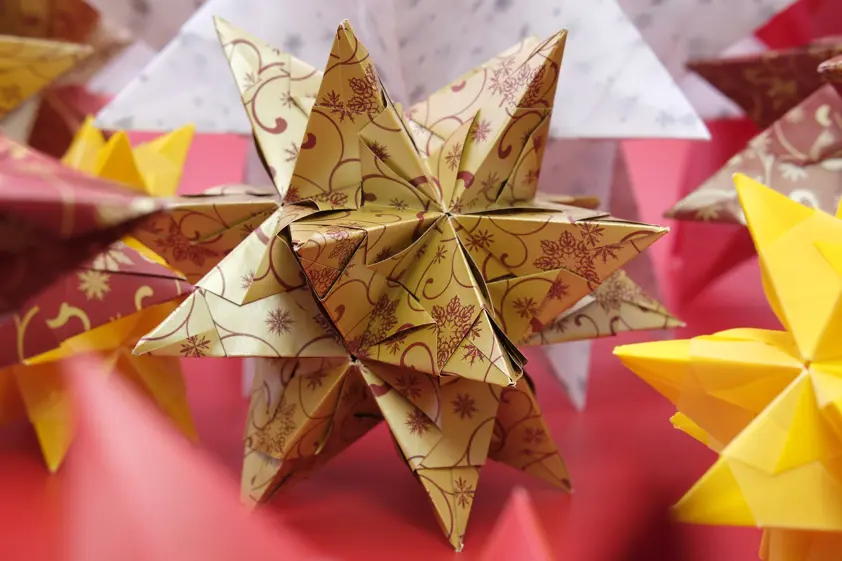Opinions differ on the precise origin of the tradition of decorating Christmas trees. The adorning of an evergreen tree with simple white candles is commonly believed to have originated in Germany. However, there is some debate about whether it was introduced around the 7th, or 8th century by Saint Boniface, an important figure in early Christianity, or later in the 16th century by Martin Luther, the protestant-reformer.
Martin Luther is said to have come upon the idea one winter evening while walking toward his home, when he was awed by the brilliance of stars twinkling amidst evergreens. He was inspired to recreate the effect by placing candles on the branches of a small fir tree inside his home.
In 1605, a tree in Strasbourg, a city on the Rhine in eastern France near the German border, was brought indoors and adorned with paper roses, lighted candles, wafers, nuts, and sweets. This is said to be a ground-breaking moment in the history of festive decorations for it kicked off a new trend, adornment of a Christmas tree in an indoor setting.
These traditions spread throughout Germany and Europe and were carried by European immigrants to the USA in the 18th and 19th centuries.
In the early 1800s, eatables such as fruit, especially apples, and nuts were popular ornaments for adorning the evergreen trees, representing the regeneration of life in the spring season. Soon other fruits also began to be hung on the tree, along with paper streamers. It was around this time that the idea of reflecting the light of the room on the tree came into being and tinsel also began to festoon the trees.
Royal influence
In the 1840s, a postcard featuring Queen Victoria with her German-born husband and their family decorating an evergreen tree transformed this tradition into a fashionable one that wealthy Americans rushed to adopt. This trend was also adopted by local businesses who caught onto the commercial potential of Christmas ornaments.
As the tradition of Christmas trees and ornaments became more widespread, each country added its own creativity to the decorations. In the USA, for example, people would string long strands of cranberries or popcorn through the boughs of their trees.
In the UK, imaginative ornaments of lace, paper or other items showed the creativity and skill of their makers. Small pieces of newspaper or magazine illustrations also began to be used to make family Christmas tree decorations.
The use of foods like gingerbread or other hard biscuits, baked into shapes such as fruits, stars, bells, angels and hearts, were also used and were especially popular in German-speaking parts of Europe.
In fact, as the amount of many decorative items increased during this period, with each passing year it became increasingly difficult to actually see the tree beneath the ornaments.
Mass-production begins
As the popularity of decorating for Christmas grew, it was quickly turned into profitable business as well.
By the early 1900s, Christmas began to grow more and more popular among Europeans and Americans, leading to the German monopoly over Christmas being broken.
Since 1925, Japan had challenged Germany’s dominance over the world market by producing ornaments on a mass scale.
In the 1930s, the Corning Company of New York used its lightbulb manufacturing machine to create glass Christmas ornaments and by 1940 they were making ornaments on a much larger scale.
Other ornaments were made of fibre board, a thick type of cardboard, and depicted angles and other scenes. Hallmark (from where?) – a company which since the early 20th century has been one of the biggest manufacturers of Christmas cards – began making their Keepsake ornaments in 1973, which has become a yearly tradition for many families.
Local flavours and DIY Christmas spirit
Even though the majority of ornaments are now mass-produced and made of plastic instead of glass and paper, the tradition of getting into the Christmas spirit by making your own decorations is alive and well. While the popularity of edible decorations has declined, paper and cardboard based crafts are showcasing the tastes and traditions of different parts of the world.
In the US, schoolchildren make their own paper garlands, which are hung around the house. One step south, in Mexico, the colourful papier-mâché piñatas are also a Christmas favourite, filled with sweets and little gifts. The Asian tradition of paper-folding is also seen in the holiday season decorations, with masterfully crafted paper fans and trees. And if you take a walk anywhere in Nordics around Christmastime, you’re sure to spot shapes of elves made of cardboard and snowflakes cut out of paper in many windows.
You can spread a little Christmas cheer with our own UPM Pulp Christmas snowflake. You’ll find the snowflake template and instructions here.
Text: Saana Kallioinen

